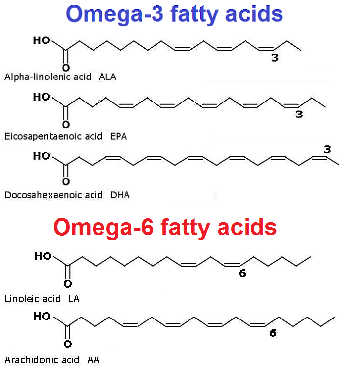
Know Facts
To Know Or Not To Know …




Fat
Body fat stores energy and insulates against cold. Fat is also an important constituent of the brain and nerves, but most importantly it is part of the membrane of all cells.
Most fats are fatty acids, which may be attached to glycerol as triglycerides or
phospholipids, which also have a phosphate-
Cholesterol is a special fat, which is produced in the body where it is a precursor for important molecules such as bile acids, steroid hormones, sex hormones and vitamin D, which are necessary for good health!
Of the fats only a few cannot be produced in the body. They are the essential  fatty
acids having the first double binding in position 3 (omega-
fatty
acids having the first double binding in position 3 (omega-
The omega-
The omega-
The essential fatty acids must be supplied with the food. All other fats are not essential and need not be present in the diet.
The essential fatty acids are important for the formation of healthy cell membranes,
proper development and functioning of the brain and nervous system, and production
of hormone-
The eicosanoids typically have a short active lifetime starting with synthesis from fatty acids and ending with metabolic elimination by enzymes. However, if the rate of synthesis exceeds the rate of metabolic elimination, the excess eicosanoids may have deleterious effects.
If both omega- the production
of their eicosanoids. So if the omega-
the production
of their eicosanoids. So if the omega-
The omega-
So, excess omega-
A high proportion of omega−6 to omega−3 fatty acids in the diet is associated with increased risk of inflammatory activity as in thrombotic disease, cardiovascular disease, type 2 diabetes, obesity, metabolic syndrome, rheumatoid arthritis, asthma, cancer, psychiatric disorders (depression, schizophrenia), and autoimmune diseases.
The excess synthesis of inflammatory omega-
Obviously, the simplest way to maintain good health would be to consume fewer omega-
Omega- growth and development.
growth and development.
Omega-
They are also important in maintaining the health of the heart and they may reduce the risk of cancer and arthritis. They also reduce inflammation.
Omega-
Omega-
Sources
The health effects of omega- richest
sources of these are
richest
sources of these are
Whitefish like cod, haddock and flatfish contain much less omega-
Important sources of ALA are oils from flaxseeds, rapeseeds, soybeans, pumpkin seeds, purslane, and walnuts.
Please note that ALA from plant sources needs to be converted in the body to EPA and DHA, and many people do not make these conversions very effectively.
Furthermore, the absorption of essential fatty acids is much less from plant than animal sources.
For these reasons oily fish would be the recommended primary source. You can see
data on the content of omega-
Fish oil supplements have passed safety standards for potential contaminants including heavy metals (mercury, lead, nickel, arsenic, and cadmium).
These metals do not accumulate in the oil but may bind with the protein in the fish flesh. However, researchers from Harvard’s School of Public Health finds that the benefits of fish intake generally far outweigh the potential risks.
Daily intake
The average modern Western diet provides plenty of omega- smaller
amounts of omega-
smaller
amounts of omega-
Thus the general recommendation would be to increase intake of omega-
An amount of 3 grams daily of omega-
Deficiency
Symptoms of omega-
Omega-
However it may be difficult to attribute certain symptoms to a specific omega-
Excess
As mentioned above the general problem with the average Western diet is the dominance
of omega-
Copyright: Know Facts -